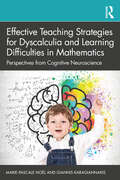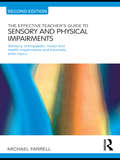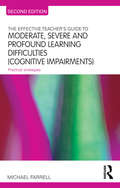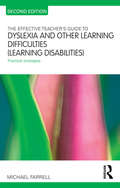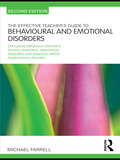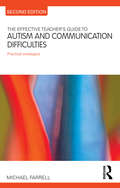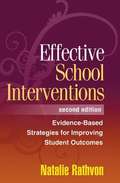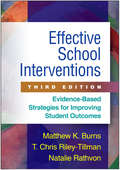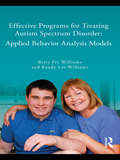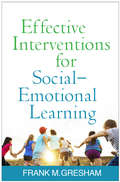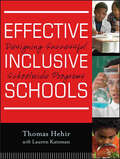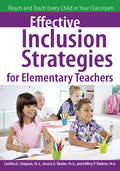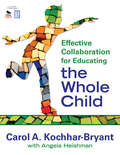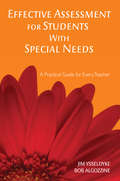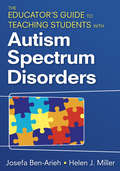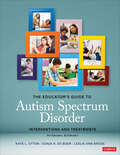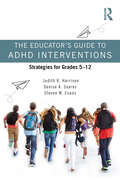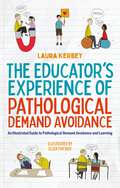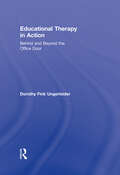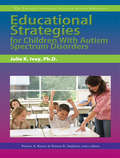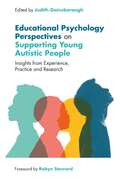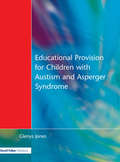- Table View
- List View
The Electric Eel
by Christopher W. CoatesDid you know that the adult eel is blind? That baby eels have bright blue eyes? That a whopping four-fifths of the eel's body is tail? There are lots more interesting things to know about eels, and you can read about them in this delightful book.
The Effects of Blindness and Other Impairments on Early Development
by Zofja S. JastrazembskaA scientific study of blind children, where there are frequently marked delays in locomotor achievements by sighted standards.
Effective Teaching Strategies for Dyscalculia and Learning Difficulties in Mathematics: Perspectives from Cognitive Neuroscience
by Marie-Pascale Noël Giannis KaragiannakisEffective Teaching Strategies for Dyscalculia and Learning Difficulties in Mathematics provides an essential bridge between scientific research and practical interventions with children. It unpacks what we know about the possible cognitive causation of mathematical difficulties in order to improve teaching and therefore learning. Each chapter considers a specific domain of children’s numerical development: counting and the understanding of numbers, understanding of the base-10 system, arithmetic, word problem solving, and understanding rational numbers. The accessible guidance includes a literature review on each topic, surveying how each process develops in children, the difficulties encountered at that level by some pupils, and the intervention studies that have been published. It guides the reader step-by-step through practical guidelines of how to assess these processes and how to build an intervention to help children master them. Illustrated throughout with examples of materials used in the effective interventions described, this essential guide offers deep understanding and effective strategies for developmental and educational psychologists, special educational needs and/or disabilities coordinators, and teachers working with children experiencing mathematical difficulties.
The Effective Teacher's Guide to Sensory and Physical Impairments: Sensory, Orthopaedic, Motor and Health Impairments, and Traumatic Brain Injury (The Effective Teacher's Guides)
by Michael Farrell'Michael Farrell offers well sourced overviews of the conflicting and contradictory advice that is available to schools, suggests a variety of solutions to challenges, empowering the reader to make their own choices.' - Carol Smart, Special Needs Information Press Fully updated with the latest research and advice on best practice, this new edition of The Effective Teacher’s Guide to Sensory and Physical Impairments covers a range of conditions that cause learning difficulties for children, including visual impairment, hearing impairment, deafblindness, orthopaedic impairment, motor disorders and health impairments, as well as a brand new chapter on traumatic brain injury. Teachers are likely to meet children with varying types and degrees of sensory and physical impairments. This comprehensive guide equips you with informed and practical strategies to ensure that all pupils are included and provided for in the best possible way. The new edition has also been adapted to be more widely relevant to readers in different countries, focusing more on the strategies that work regardless of national context. Writing in his popular accessible style, Michael Farrell suggests the best ways of dealing with a variety of conditions, always with practical classroom situations in mind. In each section, the book: explains the legal contexts looks at the range of provision suggests intervention and support strategies gives points for reflection and suggested further reading. Highly accessible and authoritative, this book provides teachers with an invaluable resource to help you create a truly inclusive classroom.
The Effective Teacher's Guide to Moderate, Severe and Profound Learning Difficulties: Practical strategies (The Effective Teacher's Guides)
by Michael FarrellThis updated second edition of The Effective Teachers Guide to Moderate, Severe and Profound Learning Difficulties (Cognitive Impairments) has been restructured and expanded to ensure it continues to meet the needs of the busy teacher. This new edition is highly relevant and contextualized, drawing on the curriculum and assessment, pedagogy, resources, therapy and care and school and classroom organisation. It is accessible and practical in approach yet offers the necessary underpinning of research and professional knowledge to enable the teacher to be self-critical in developing classroom approaches. The book accessibly and thoroughly discusses the classroom difficulties associated with: Mild cognitive impairment Moderate to severe cognitive impairment Profound cognitive impairment Conditions associated with cognitive impairment. A much needed source of knowledge for teachers, students on initial teacher training courses, school managers, and administrators, this book will be of interest to anyone who supports children and young people with cognitive impairments.
The Effective Teacher's Guide to Dyslexia and other Learning Difficulties: Practical strategies (The Effective Teacher's Guides)
by Michael FarrellThis highly anticipated second edition of The Effective Teacher's Guide to Dyslexia and other Learning Difficulties (Learning Disabilities) critically examines the specificity and complexity of learning disabilities. The user-friendly text highlights the importance of schools reviewing their curricula and assessment, pedagogical methods, resources, organisation and therapy procedures to ensure that their provision helps encourage academic progress and the best personal and social development for their pupils. This book accessibly and authoritatively addresses a range of issues associated with: Reading disorders / dyslexia Disorder of written expression/ dysgraphia Developmental co-ordination disorder/ dyspraxia Mathematics disorder/ dyscalculia. Offering what works in the classroom, this text also takes into account the relationship between professionals who work closely with parents and other professionals. It helpfully recognises the importance of professional contributions and the foundational disciplines that contribute to special education. Underpinned by research and widely held professional opinions, this second edition of The Effective Teacher's Guide to Dyslexia and other Learning Difficulties (Learning Disabilities) will prove a practical, readable and invaluable resource for the busy teacher, students on initial teacher training courses, school managers and administrators.
The Effective Teacher's Guide to Behavioural and Emotional Disorders: Disruptive Behaviour Disorders, Anxiety Disorders, Depressive Disorders, and Attention Deficit Hyperactivity Disorder (The Effective Teacher's Guides)
by Michael Farrell'Michael Farrell offers well sourced overviews of the conflicting and contradictory advice that is available to schools, suggests a variety of solutions to challenges, empowering the reader to make their own choices.' - Carol Smart, Special Needs Information Press Fully updated with the latest research and advice on best practice, this new edition of The Effective Teacher’s Guide to Behavioural and Emotional Disorders covers a range of conditions that cause learning difficulties for children, including disruptive behaviour, attention deficit hyperactivity disorder, anxiety and depressive disorders. The theoretical underpinning is fully updated but also condensed in this edition to make way for more practical strategies for teachers. Teachers are likely to meet children with varying types and degrees of emotional behavioural disorders. This comprehensive guide equips you with informed and practical strategies to ensure that all pupils are included and provided for in the best possible way. The new edition has also been adapted to be more widely relevant to readers in different countries, focusing more on the strategies that work regardless of national context. Writing in his popular accessible style, Michael Farrell suggests the best ways of dealing with a variety of conditions, always with practical classroom situations in mind. In each section, the book: sets out the definitions of the condition looks at the range of provision suggests intervention and support strategies gives points for reflection and suggested further reading. Highly accessible and authoritative, this book provides teachers with an invaluable resource to help you create a truly inclusive classroom.
The Effective Teacher's Guide to Autism and Communication Difficulties: Practical strategies (The\effective Teacher's Guides)
by Michael FarrellIn this welcome second edition of The Effective Teacher‘s Guide to Autism and Communication Difficulties, best-selling author Michael Farrell addresses how teachers and others can develop provision for students with autism and students that have difficulties with speech, grammar, meaning, use of language and comprehension. Updated and expanded, thi
Effective School Interventions, Second Edition
by Paula Freer Natalie RathvonThis highly practical resource and text presents 70 interventions that have been demonstrated to improve the classroom learning environment, academic achievement, and student behavior and social competence. Each intervention is presented in a brief, standardized format with step-by-step procedures that can easily be implemented by Pre-K-12 teachers and other school-based professionals. The volume includes best-practice guidelines for designing, implementing, and evaluating evidence-based school interventions, as well as strategies for combining multiple interventions to create a comprehensive program at the individual, class, or school wide level. New to This Edition Substantially revised and expanded to reflect significant developments in research and practice. Designed for full compatibility with a response-to-intervention framework.42 of the 70 interventions are entirely new. More in-depth discussions of intervention procedures facilitate implementing and adapting the techniques. A new chapter on preschool interventions. Expanded coverage of curriculum-based measurement procedures. A new category of proactive interventions targeting positive relationships in the classroom.
Effective School Interventions: Evidence-Based Strategies for Improving Student Outcomes
by Matthew K. Burns T. Chris Riley-Tillman Natalie RathvonThis indispensable course text and practitioner resource, now fully revised, has helped tens of thousands of readers implement evidence-based interventions to improve students' academic achievement and behavior in PreK–12. The volume presents best-practice guidelines and step-by-step procedures for 83 interventions that can easily be implemented by teachers and other school-based professionals. It is a go-to book for those working in a multi-tiered system of support (MTSS) or response-to-intervention (RTI) framework. User-friendly features include recommended print and online resources and 10 reproducible forms. Purchasers get access to a webpage where they can download and print the reproducible materials in a convenient 8 1/2" x 11" size. New to This Edition: *Updated throughout to reflect current research-based best practices. *20 new interventions. *Chapter on important skills for intervention success. *The intensity of each intervention (classwide, small-group, and/or individual) is now specified. *Behavior chapter has been reorganized for easier use. *Downloadable reproducible tools.
Effective Programs for Treating Autism Spectrum Disorder: Applied Behavior Analysis Models
by Betty Fry Williams Randy Lee WilliamsEffective Programs for Treating Autism Spectrum Disorder is written for teachers, parents, and the many service providers who work with individuals with autism spectrum disorder (ASD). Part one reviews the characteristics of ASD, summarizes major theories and research findings regarding cause(s) of ASD, and discusses the most popular treatment claims, examining each approach's scientific base and value. Part two provides an informative overview of applied behavior analysis, focusing on the principles of learning and basic procedures based upon those principles. These two parts provide a foundation for understanding the strategies implemented by the outstanding treatment programs described in Part three. The eight models described in Part three represent comprehensive, evidence-based programs for the treatment of persons with ASD, from infancy through adulthood. Programs reviewed include the Lovaas Institute, Koegel Center, Strategic Teaching and Reinforcement Systems (STARS), Project DATA, New England Children's Center, May Institute, Princeton Child Development Institute, and Judge Rotenberg Center. Strategies explained include intensive early behavioral intervention, Pivotal Response Training, verbal behavior, script fading, social stories, visual activity schedules, functional analysis, the Picture Exchange Communication System, and the Family-Teaching Model.
Effective Interventions for Social-Emotional Learning
by Frank M. GreshamThis book reviews evidence-based, multi-tiered practices for promoting social-emotional learning (SEL) with typically developing students as well as those with special needs. Leading authority Frank M. Gresham, codeveloper of the Social Skills Improvement System--Rating Scales, describes how to systematically assess K-12 students' social skills and plan and implement universal, selected, and intensive interventions. His approach is grounded in cutting-edge research on social-emotional competencies and their role in adjustment and academic achievement. Emphasizing what works, the book showcases programs and strategies that are sequenced, active, focused, and explicit. Detailed case examples and lesson plans illustrate different levels and types of SEL intervention. Reproducible assessment tools can be downloaded and printed in a convenient 8 1/2" x 11" size.
Effective Inclusive Schools
by Thomas Hehir Lauren KatzmanHow to raise the achievement of all kids, from gifted to those with severe disabilities This book presents lessons learned from in-depth case studies of some of our most effective inclusive public schools. The authors conclusively demonstrate that schools can educate students with mild and severe disabilities in general education classrooms by providing special education services that link to and bolster general education instruction. This goes beyond complying with Special Education law; having a truly inclusive environment raises the achievement level for all students and results in more committed and satisfied teachers. Insights shared from teachers, school leaders, parents, and the students themselves provide a path forward for anyone striving to Improve special education services. The authors reveal what these exemplary schools do that makes them so successful, and provide advice for readers who want to incorporate these practices themselves. Hehir, former U. S. Office of Special Education (OSEP) Director, is a leading name in Special Education Highlights the important relationships between administrators, teachers, and parents to foster maximum collaboration between general and special education Includes information on committing to Universal Design for Learning (UDL) and Positive Behavior Supports This vital resource zeroes in on what excellent public schools do differently to ensure all students succeed.
Effective Inclusion Strategies for Elementary Teachers
by Cynthia Simpson Jessica Reuter Jeffrey BakkenWritten in a very reader-friendly style with many examples and suggestions, Effective Inclusion Strategies for Elementary Teachers addresses some of the very important issues elementary school teachers face when working with students with disabilities. Topics include an overview of disability laws and definition of inclusion, followed by chapters on students with specific disabilities (autism spectrum disorders, ADHD, learning disabilities, emotional and behavioral disorders, speech and language impairments, hearing impairments, visual impairments, orthopedic impairments, and intellectual disabilities).The remaining chapters in this book discuss the very important topics of technology, collaborating with families, and Response to Intervention. This guide for elementary school teachers is a resource they can come back to over and over again!
Effective Collaboration for Educating the Whole Child
by Carol A. Kochhar-Bryant Angela S. HeishmanEducate the whole child by building a culture of collaboration in your school! This book for K–12 general and special education teachers, administrators, and student support specialists explores how to make collaboration and coordination work, who takes responsibility for the process, and why collaboration is central to improving outcomes for students with complex learning needs. The author: Discusses the roles, responsibilities, and relationships between school professionals, community agencies, and service providers Offers case examples as real-world illustrations of collaboration Emphasizes important developmental transitions from the elementary years through high school and after
Effective Assessment for Students With Special Needs: A Practical Guide for Every Teacher (Practical Approach To Special Education For Every Teacher Ser.)
by Bob Algozzine Dr James E. YsseldykeDiscover what assessment methods you should be using, and how, when, and where they should be administered to ensure appropriate services are selected for all exceptional students.
The Educator's Guide to Teaching Students With Autism Spectrum Disorders
by Josefa Ben-Arieh Helen J. MillerUse this guide to identify students with ASD, organize the classroom; manage time; promote independence, communication, and appropriate behaviors; and select visual strategies, tools, and curriculum resources.
The Educator′s Guide to Autism Spectrum Disorder: Interventions and Treatments
by Kaye L. Otten Sonja R. de Boer Leslie Ann BrossIdentify the best interventions to fit the unique needs of each learner with autism Whatever your role—general or special education teacher, school counselor, therapist, behavior analyst, administrator—you undoubtedly interact with learners with autism spectrum disorder (ASD) and are committed to helping them succeed and thrive. This easy-to-use accessible guide summarizes more than 75 interventions and rates each based on the most recent evidence of effectiveness and safety. Features include: A summary of interventions and treatments from a comprehensive variety of domains organized into 11 categories, including behavioral interventions, visual supports, social and emotional skills training, and physiological interventions, as well as interventions that have the potential for causing harm An evidence-based five-point scale that clearly rates each intervention’s effectiveness for specific learners Guidance for working with colleagues and families to choose and implement the most promising treatments Written by educators with decades of experience and expertise in a variety of settings, many of whom are also Board Certified Behavior Analysts, this comprehensive guide is an indispensable resource for all those who serve students with ASD.
The Educator′s Guide to Autism Spectrum Disorder: Interventions and Treatments
by Kaye L. Otten Sonja R. de Boer Leslie Ann BrossIdentify the best interventions to fit the unique needs of each learner with autism Whatever your role—general or special education teacher, school counselor, therapist, behavior analyst, administrator—you undoubtedly interact with learners with autism spectrum disorder (ASD) and are committed to helping them succeed and thrive. This easy-to-use accessible guide summarizes more than 75 interventions and rates each based on the most recent evidence of effectiveness and safety. Features include: A summary of interventions and treatments from a comprehensive variety of domains organized into 11 categories, including behavioral interventions, visual supports, social and emotional skills training, and physiological interventions, as well as interventions that have the potential for causing harm An evidence-based five-point scale that clearly rates each intervention’s effectiveness for specific learners Guidance for working with colleagues and families to choose and implement the most promising treatments Written by educators with decades of experience and expertise in a variety of settings, many of whom are also Board Certified Behavior Analysts, this comprehensive guide is an indispensable resource for all those who serve students with ASD.
The Educator’s Guide to ADHD Interventions: Strategies for Grades 5-12
by Judith R. Harrison Denise A. Soares Steven W. EvansDesigned specifically for middle and high school educators, this guidebook clearly and thoroughly breaks down effective classroom-based interventions for students with ADHD. Chapters walk readers through each intervention, providing step-by-step implementation guides, describing potential pitfalls and offering critical tips and advice to help you ensure that your interventions are both culturally responsive and sustainable. Filled with helpful templates and tools, this book is essential reading for anyone who needs help creating effective, sustainable interventions for students with ADHD.
The Educator’s Experience of Pathological Demand Avoidance: An Illustrated Guide to Pathological Demand Avoidance and Learning
by Laura KerbeyI realised EVERYTHING I was doing was wrong.I needed to learn.I needed to change.During Laura Kerbey's time teaching autistic children, she had a sudden realisation that those with Pathological Demand Avoidance (PDA) are children like no other! None of her tried and tested autism strategies would work to help them focus or learn and most of her time was spent wondering, what am I doing wrong?If you feel the same, this short, easy-to-read guide is here to teach you everything you need to know from one educator to another. With an introduction to what PDA is followed by PDA tailored advice on how to connect with your student and create an autonomous, spontaneous environment that is personalised for you both, this guide is here to ensure that you and your PDA student thrive!Illustrated by the popular Eliza Fricker and packed with entertaining anecdotes (including one about Jabba the Hut's poo), this go-to-guide contains everything you need to start implementing PDA friendly learning to help you connect with your student and help them make the most of their learning experience.
Educational Therapy in Action: Behind and Beyond the Office Door
by Dorothy Fink UngerleiderThis book provides an in-depth look at what a little-known clinician, the educational therapist, does and how they do it. It goes behind the clinician’s door to illustrate the unusual and broad range of interventions – both academic/vocational and social/emotional – that an educational therapist employs. This particular case study involves a young woman named Nora who had a severe but undiagnosed auditory processing disorder. She could not give meaning to the spoken language that came at her too rapidly, leaving her in a constant fog of words that she couldn’t comprehend. This case discloses the problems, their causes, and the emotional toll that had to be considered when developing an effective educational/therapeutic plan for Nora. It vividly illustrates the dynamic exchanges and mutual learning that goes on between client and therapist. Parts I and II illustrate how the psycho-educational interventions that addressed Nora’s academic and non-academic needs were gradually formulated over the first year. Part III provides a series of vignettes from subsequent years that illustrate the ongoing applications of the therapist’s work. Distinguishing Features Explanatory Sidebars – The rationale behind particular techniques and interventions is clarified through a system of explanatory sidebars that inform the reader without distracting from the story. This approach makes the book both an instructional tool well as compelling story. Organic Curriculum – The rationale for and application of an "organic (personalized) curriculum" is explained and applied throughout the book as a model for others to use in working with this population. A Longitudinal Perspective – The initial work with Nora began many years ago, so this book provides a long view of her life and tracks the influences that educational therapy exerted on her development into a fully functioning adult. Cognitive/Emotional Integration – The core of educational therapy – the interdependence of cognitive skills and emotional response – is clearly documented throughout the book. In addition to educational therapy students and practitioners, this book is appropriate for those working in related fields such as special education, school psychology, school counselling, and social work in educational settings.
Educational Strategies for Children With Autism Spectrum Disorders
by Julie K. IveyFocusing on educational and instructional strategies that are successful with students with autism spectrum disorders, Educational Strategies for Children With Autism Spectrum Disorders profiles the most current, research-based interventions that can be implemented by teachers in a classroom setting. Because autism spectrum disorders are on a continuum, educational placements can range from specialized autism classrooms to full-time inclusion in a general education classroom. It is important for teachers and staff to understand the various educational strategies that are available. It is the goal of this book to provide interventions and strategies to help teachers and staff best serve students on the autism spectrum. Strategies include applied behavior analysis, the Developmental, Individual Difference, Relationship-Based (DIR) model, discrete trial training, Picture Exchange Communication System (PECS), Pivotal Response Treatment (PRT), Sensory Integration Therapy, and Social Stories, among others.
Educational Psychology Perspectives on Supporting Young Autistic People: Insights from Experience, Practice and Research
by Laura Cockburn Dr Laura Crane Liz Pellicano Vicky Slonims Jennifer Baulcomb Carrie Grant Scot Greathead Rhiannon Yates Phil Christie Bola Abimbola Luke Beardon Diana Loffler Annie Etherington Carol Povey Irina Roncaglia Charlotte Hatton Jane Park Katie Maras Clare Hughes Adam O'Loughlin Alexandra Lewis Juliet Gittens Lynne Moxon Prithvi Perepa Ken Greaves Alyssa Alcorn Sue Fletcher-Watson Nicola Yuill Owen Rhys BarryAn essential guide for any professionals working with autistic children and young adults, this book provides expert insights which need to be considered by professionals, parents and autistic people alike. It covers key themes such as anxiety and wellbeing, transition into adulthood, sexuality, intersectionality, and many more.A unique blend of first-hand experience, parental guidance and professional advice is provided from prominent figures in the autism field to offer you an overview of the important issues of today, to help you understand and better support autistic young people.
Educational Provision for Children with Autism and Asperger Syndrome: Meeting Their Needs
by Glenys JonesThe range of educational options available to a child with Autism and Asperger syndrome is broad, but choosing the right path can often be a complex task for all involved. This book provides information and advice for professionals and parents making crucial decisions about meeting the needs of children with autistic spectrum disorder. It covers the range of intellectual ability from those having severe learning difficulties to those of above average intelligence. Practical advice for those working with children from preschool to post-16 is given on: choosing the most appropriate educational placement; making decisions on which educational interventions to follow; creating an effective educational environment; working with staff and other children to maximum effect; writing effective individual education plans; working with parents and families; enabling a smooth transition between classes and stages of education; and life beyond school.

